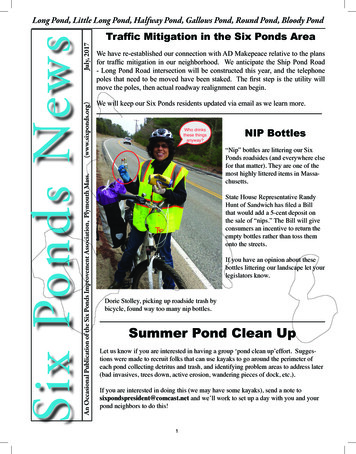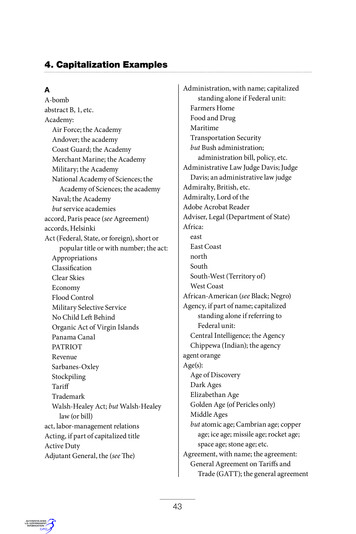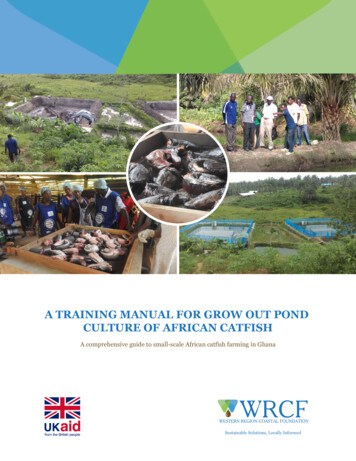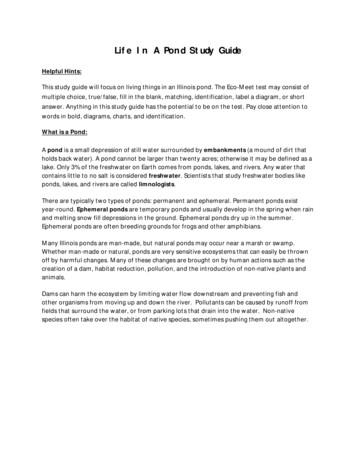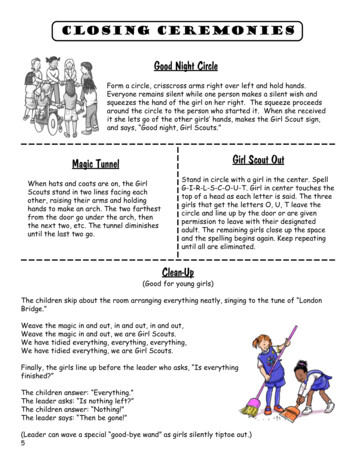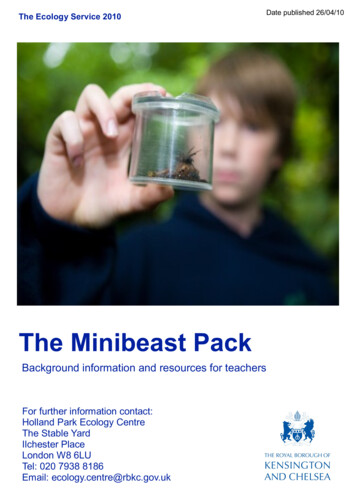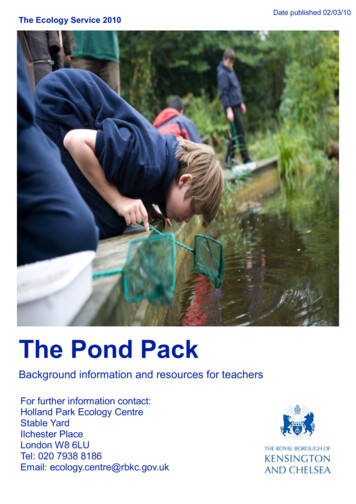
Transcription
The Ecology Service 2010Extended artwork area(REMOVE THIS TEXT)The Pond PackBackground information and resources for teachersFor further information contact:Holland Park Ecology CentreStable YardIlchester PlaceLondon W8 6LUTel: 020 7938 8186Email: ecology.centre@rbkc.gov.ukDate published 02/03/10
IntroductionThis pack contains useful resources and ideas about pond dipping at Holland Parkfor KS1 and KS2 teachers. The content and activities can be adapted to suit thedifferent needs of classes and age groups. It aims to give teachers a betterunderstanding of the habitat and provides suggestions for pre and post visitactivities.The pack contains photocopiable worksheets and identification sheets that may beused on the visit or could form the basis for follow up work.Key vocabulary is written in bold in the text and a short definition of each term canbe found in the glossary along with suggestions for further reading.ContentsPrevisit ideasPost visit ideasHow to pond dipInformation about the pond and its inhabitantsPond invertebrate identification sheetsPond invertebrate keyWorksheetsGlossary and further readingLetter to class about their forthcoming visit2
Why Pond dipping?Pond dipping is a fun and simple way for children to explore an aquatic habitat.Children will be able to observe a diversity of different creatures from leeches todragonfly nymphs. It is a useful tool in delivering the science primary curriculumsection on life process and living things (Sc2). It can also be used as a stimulus forart, English or maths activities.How to Pond dip for self led groupsThe Ecology Centre will provide all the equipment needed. This will consist of whitetrays (one per pair), magnifiers (one per pair), nets, identification sheets and keys.At the wildlife area there is a large dipping platform by the wildlife pond. Beforestarting pond dipping with the group please remind them of health and safety andbehaviour rules. Ask the group to sit away from the pond.Half fill the white trays with pond water, place the trays along the platform pond’sedge and put a net either side of the trays. Invite children to start pond dipping;younger children should lie on their stomachs with only their heads peering over thepond platform edge whilst older children can kneel by the edge.Up to six pairs (12 children) can do pond dipping at once. In large groups the waitingchildren could look at a dipped tray or do sketching of the pond.Allow the children up to ten minutes to pond dip. Adults should then carry the traysto a place on the platform away from the pond edge and hand each pair a magnifierto observe their finds.The best way to pond dip is to make a figure of eight or a circle in the water. Dippingby plants or by the edge is often more productive. Try not to dip too much mud asthis will make it hard to see any creatures caught. Turn the net gently inside out intothe pond tray so the creatures can swim out. Let the water settle and look at whatyou’ve caught.After dipping gently tip the tray water back into the pond and rinse the trays and netsin the pond.3
Health & Safety and Risk AssessmentPond dipping is a very enjoyable activity but it does carry a number of potentialrisks, these can be easily reduced by following these guidelines.1.Group ratio: Please ensure you have a ratio of at least one to eight by thepond.2.Behaviour by the pond: All children should be made aware of the deep waterand asked not to run or be silly near the edge.3.Pond dipping should only be carried out by children kneeling on both knees orlying flat on their stomachs.4.Weil’s disease is a water borne disease; to prevent infection all open cuts andgrazes should be covered with a waterproof plaster or pvc gloves as required.5.To prevent infections children should be reminded not to put their fingers intheirs mouth, nose or eyes and should wash their hands afterwards.A full risk assessment for this activity is available on our website. Please contact theEcology Centre for further enquiries. It is advisable to have the Ecology Centre andParks Police numbers to hand when at the wildlife area in Holland Park.4
Previsit IdeasBefore coming to the Ecology Centre with your class you may find the followingideas useful to set the scene and further learning.Discuss the term minibeast and invertebrate - compare and contrast withother animals including themselves. Appearance, lifecycle, movement, howthey get oxygen.Revise what is a habitat.Display enlarged pictures of common pond animals (from the enclosed IDsheets or pictures from the web) and ask them to research their favouritepond creature – internet or book based (ICT/science).Discuss what might live in a pond and what all animals need to survive.Work on food chains and food webs - construct a simple food chain aboutknown animals to contrast with those found in a pond.Work on keys to identity creatures or objects.Devise a code of conduct for pond dipping (citizenship and H&S)Work on lifecycles particularly that of the frog. If your visit is in springtimethe pond should have frog and toad tadpoles in it, later in early summer thepond should have efts (newt tadpoles) present. All year round the pond ishome to invertebrates like mayfly and damselfly nymphs.Read to the class the ‘dear class’ letter from this pack as a way to stimulateinterest and gauge understanding.5
Post visit ideasTo consolidate learning a follow up or post visit activity is often useful. This couldtake the form of a short task or a more longer term project.Possible suggestions:Create minibeast pond creatures using clay and natural materials from thewildlife area or art materials back at school.Display work about pond creatures- children could draw or paint differentminibeasts this could help reinforce work on adaptation, movement and wherethey live in the pond.Children could write a story in first person as an invertebrate or tadpole livingin the wildlife pond and the dramas it faces to survive. (Literacy link)Recount of trip or a non chronological report writing about the creatures foundin the pond (Literacy link).Use the data collected on tally charts to produce graphs to different graphs.(Numeracy and data handling).Play pond food chain or food web games to enable children to appreciate theimportance of invertebrates.Comparison work with another habitat such as the woodland.Pond pollution - learn about 'indicator' species and find out which of the freshwater minibeast are indicators of clean water (Yr 6) (see pond survey sheet).6
Pond Food chains and food websA food chain shows a simplified feeding relationship in a habitat. They are useful inshow how plants and animals are connected. Food webs show the differentrelationships more fully as many food chains interconnected.Green plants are termed producers as they convert energy from the sun into foodfor themselves by a process called photosynthesis.ConsumersConsumers are animals that get their energy directly or indirectly from plants.Primary consumers or herbivores eat plants as their source of energy.Animals that eat other animals are called carnivores. In a food chain secondaryconsumers eat primary consumers to obtain their energy while a Tertiaryconsumer is one that eats a secondary consumer other animals.Omnivores eat both plant and animals.Detritivores eat dead organic matter (plants or animals) to survive.Examples of animals for each group are given below and overleaf but this is asimplified version as many animals fall into more than one category.7
Pond Food ChainsAll animals and plants need food to grow and move.Animals that eat plants are called herbivores.Animals that eat other animals are called carnivores.Animals that eat both plants and animals are called omnivores.Animals that eat dead plants and animals are called detritivores.This is a simplified feeding or tropic level chart of the animals found in our pond.Invertebrate NameFeeding or Trophic levelPond snailHerbivore/ DetritivorePhantom midge larvaeCarnivoreMidge larvaHerbivoreRat-tailed yfly nymphHerbivoreDragonfly nymphCarnivoreDiving beetleCarnivoreWater miteCarnivoreFreshwater hoglouseDetritivoreFreshwater shrimpDetritivoreWater fleaHerbivorePea musselHerbivoreGreater water boatmanCarnivoreLesser water boatmanHerbivoreMosquito larvaHerbivoreDamselfly nymphCarnivoreWater voreTadpoleHerbivore8
Information about Pond WildlifeInvertebrates – animals without backbonesA healthy British pond can be home to a vast diversity of invertebrates over 115species.; Some of which only complete part of their lifecycle in the pond whilstothers need an aquatic environment for all of their lifecycle.Most species are insects there are also crustaceans, annelids (worms), snails andarachnids (spiders and their relatives).The diversity of species is dependent on water quality as a general rule the morepolluted a watercourse is the fewer the number of species.Insect Larvae and NymphsMany flying insects lay their eggs in the pond and their young called nymphs orlarvae live under water before changing into adults. .Larvae are maggot-like insect young, sometimes with legs.Mosquito larvaMidge larvaPhantom Midge larvaNymphs look more like adult insects but without wings, usually with jointed legsMayfly nymphA number of different mayfly species lay their eggs in the pond, some take only twomonths to mature as adults whilst other species take two years. The presence ofmayfly in the pond shows the pond has high water quality. Mayfly are very shortlived as adults although one species can live for a fortnightDamselfly nymphDamselfly nymphs live underwater for about six months before turning into an adult.The main species recorded is the common blue damselfly.Dragonfly nymphDragonfly nymphs can live underwater for up to two years before turning into adults,dependent on the species. The main species seen flying as adults are the emperorand ruddy darterBoth damselfly and dragonfly nymphs are voracious predators with larger nymphspreying on tadpoles.9
Information on Pond Wildlife cont.Pond invertebratesCommon invertebrates who live all their lives in the ponds are:Crustaceans (animals that are related to crabs and shrimps)Daphnia or water fleas – tiny free swimming crustaceans that mainly feedon algae. They are termed water fleas because they swim in a jerky motion.They are the most common animal in the pond and vary in colour from orange toalmost transparent.Cyclops – similar in size to daphnia. Termed Cyclops as they only have oneeye like the giants in Greek mythology.Water or hoglouse – related to woodlouse, these live at the bottom ofthe pond feeding on dead organic matter. Water louse carry their eggsand small young on their tummies.Freshwater shrimp – smaller freshwater species of marine shrimps.They belong to the decapods as they have ten legs.Molluscs – gastropodsPond snails – the two types that are found in our pond are the ramshornand the great pond snail. Both are mainly plant eaters but will eat dead animal andplant matter.Insects (six legs and three body parts)Greater water boatman – fast moving predators who swim upside downcatching prey with their jaws.Lesser water boatman – not closely related to the greater water boatman. Thesecreatures swim the right way up and eat algae.Greater Diving beetle – a large carnivore that breathes using a bubble ofair on its body.Water scorpion – not related to scorpions. It has large front legs forcatching its prey and its long tail acts as a snorkelPond skater – lives on the surface of the pond and hunt for strugglinginsects by vibration. Their feet have water repellent hairs that hold tinyair bubbles to allow them to walk on water.OtherLeech – related to worms and are parasites. They feed on the bodyfluids of other animals attaching themselves by a sucker. None of theleeches in our pond can pierce human skin. Leeches can swim butmost often move along the bottom of the pond.10
Information on Pond Wildlife cont.Vertebrates (animals with a backbone)AmphibiansThe park is home to three species of amphibian, the common frog, the commontoad and the common newt. An amphibian is a moist skinned animal which has agilled aquatic larva that transforms into an adult with air breathing lungs.Common toad – toads tend to be larger than fogs and have more wartyskins and are poorer jumpers. They can vary in colour from dark brownto orange. They come to the pond in spring to spawn and toad spawn islaid in long strings. Toad tadpoles are darker and smaller than frogtadpoles They also tend to swim in large shoals. Once changed fromtadpoles to toadlets they hide under rocks, logs and in deep vegetation.Common Frog – frogs have smooth skin and are excellent leapers. Frogspawn is laid in clumps in early spring and tadpoles are present in thepond until about May. After metamorphosis the young froglets leave thepond for long grass and woodland.Both frogs and toads produce a lot of spawn or eggs, over 5000 eggs maybe in astring of toadspawn. Out of this number only a handful will reach maturity due toheavy predation from other creatures including water beetles, dragonfly nymphs andbirds.Common newt – newts return to the pond in latespring to breed. Female newts are brown in colourand the males are brighter in colour with spots.Newts lay their eggs individually wrapped in theleaves of submerged plants and newt tadpoles arecalled efts. They are light brown in colour and havegills.11
Information on Pond Wildlife cont.Vertebrates (animals with a backbone)BirdsMoorhenA pair of moorhens are resident on the pond all year round, during the summer theycan have up to three broods and feed on pond vegetation and invertebrates.MallardMallard ducks nest around the park. In earlyspring a number of mallard often appear onthe pond before pairing to breed. The duckcan lay up to 15 eggs so large broods ofducklings are not uncommon, sadly most donot survive.Grey heronHeron will come to the pond tofeed on small amphibians.12
Identification sheetsIdentification of pond invertebrates can at first be difficult. It can be made easier byfocusing on features like size, number of legs and number of body parts. How theanimal moves and behaves is also another good tool to identification.The following sheets and keys contain pictures of animals commonly found in ourwildlife pond. It may be useful to also bring a field guide like the FSC guide toaquatic invertebrates as well.The colour of the animals on the sheets is generally accurate but many animals canbe differently coloured from what is showed depending on the time of year, stage intheir lifecycle and individual variation.Identification sheet 1 is suitable for foundation and key stage 1/2.Identification sheet 2 contains more detail about the animals and is suitable forupper key stage 2.The key serves as a basic introduction to a branching database or a dichotomouskey for key stage 2.PondWa- Fres FresDDiv-C Wa- PonDraDaMayMos Mid FlatTad- New LeePonRaPeaIllustra-13
Identification Sheet 1Pond AnimalsWater fleas (very small)Freshwater hoglouseFreshwater shrimpDiving beetleWater boatmanPond skaterDragonfly nymphDamselfly nymphMayfly nymphMosquito larvaMidge larvaFlatwormTadpolesNewtPond snailRamshorn snailDaphniaCyclopsLeechPea mussel14Illustrations by Graham Giddens RBKC Ecology Service
Pond AnimalsBugsLesser Water boatmanGreater Water boatmanWater ScorpionThese swim on their backsh5-40mm5-40 mmc15-25 mmcBeetleLeechDiving beetleDiving beetle Larvac25-40 mm25-60 mmccpUp to50 mmAmphibiansTadpoleNewtMales are spotted,females are brown.9-15 cmhUp to 50 mmcOtherKEYWater MiteFlatwormc : carnivoreh : herbivored : detritivore/scavengerp : parasitec5-15 mmSize:c8-15 mm15
Pond AnimalsShellsPea musselh2-7 mmPond snail20-40 mmhRamshorn snailh5-30 mmCrustaceansWater fleas (very small)h0.5-2 mmFreshwater shrimpdFreshwater hogloused15-30 mm5-15 mmLarvae (immature insects not resembling adults)Mosquito larvah2-10 mmMidge larvahUp to15 mmPhantom Midge larvac5-25 mmNymphs (immature insects resembling adults)Dragonfly nymphcUp to 60 mmDamselfly nymphc1615-30 mmMayfly nymphhUp to 20mm
Pond Invertebrate KeySTART HEREWater fleasORYESIs it really small (less than 2mm)?Midge larvaNODaphniaNOCyclopsDoes it have legs?NODoes it have a shell?YESIs it living atthe bottom ofthe tray?NORamshorn snailYESYESORPond snailLeechNODoes it have 6 legs?YESFreshwater hoglouseDoes live on the surface of thewater?Water boatmanYESNODoes it have a tail?YESPond skaterNOAre a pair of legsmuch larger thanthe rest?NODiving beetleYESYESDoes it have 3 tails?NOFreshwatershrimpORIs its body largeand broad?NOYESMayfly nymphYESWaterScorpionDoes it have large eyes ?Damselfly nymphORNODragonfly nymph17Beetle larvaIllustrations by Graham Giddens RBKC Ecology Service
PondDippingName:Keep a tally of the creatures that you find.Pond AnimalTallyMayfly nymphTotal818
Name:Date:Draw four of the animals that you have found and name them. If time write a few sentences about theircolour, how they move and what you think they might eat.19
Name:Date:There are many types of invertebrates. Some have no legs, some have 6 legs and some have many legs. This can be veryhelpful in identifying the animals that you find.1) When you have caught some animals look at each animal closely and try to identify them using the number of legs to helpyou. Then fill in the tableName of creatureNo legsSix legsMore than sixlegsNumber foundPond SnailWater FleaLeechWater BoatmanWater LouseTadpoleFreshwater ShrimpPea MusselMayfly NymphDragonfly NymphBloodwormFlatwormWater Mite2) Which creature have you caught the most of?20If time draw a picture of your favourite pond invertebrate on the back of this sheet
All animals and plants need food to grow and move.Animals that eat plants are called herbivores.Animals that eat other animals are called carnivores.Animals that eat both plants and animals are called omnivores.1) When you have caught some minibeasts look at each animal closely. Fill in the table below.Name of minibeastHerbivoreCarnivorePond SnailWater FleaLeechWater BoatmanWater LouseTadpoleFreshwater ShrimpPea MusselMayfly NymphDragonfly NymphBloodwormFlatwormWater Mite21OmnivoreNumber ofeachcreaturefound
2) Which animals did you find the most of? Why do you think there are so many ofthis animal?All animals and plants depend on each other for food and these relationships arecalled Food Chains or Food Webs.3) Fill in the spaces in the Pond Food Chain that is drawn below.Water fleas eatsthe pondweedDragonfly nympheats theeats theDragonfly nymph4) Draw a food chain using of one or more of the pond minibeasts that youhave found. You can use larger animals such as frogs or birds in your foodchain if you need to but you must use at least one minibeast.22
Glossaryproducers, consumers, herbivore, carnivore, omnivore, detritivore, adaptation,trophic levelFurther ReadingBeebee, T. (1992) Pond Life. Whittet.Fitter, R. and Manuel, R. (1994) Collins Photo Guide - Lakes, Rivers, Streams andPonds of Britain and NW Europe. Collins.Bebbington, K. and Orton, R. (1995) The Freshwater Name Trail. Field StudiesCouncil.Bernard, G., Coldfrey, J. and Thompson, G. (1984) The Pond. OSF.23
Letter to read to classSuitable for key stage 1 and lower key stage 2Dear Class,We are happy to hear that you are coming to Holland Park Ecology centre to studyhabitats. The two we have in our wildlife area are a woodland and a pond. Canyou think of some features each of these habitats?At the pond, you will have the chance to do pond dipping, have you ever done thatbefore and can you think of ways or instructions we will need to follow to keepeveryone safe and happy by the pond? What creatures might live in our pond? Ifyou are coming in spring you should catch some tadpoles and maybe newts. Doyou know what type of animal these are and what the lifecycle of them? Manyother creatures only live part of their lives in the pond – have you ever heard ofnymphs and larvae?In the woodlands you will be hunting for invertebrates or minibeasts. Can youthink why we will use spoons to pick them up? All sorts of invertebrates areadapted to live in different parts of the woodland. Some are herbivores or primaryconsumers; some are predators or carnivores whilst others eat dead plants andare called detritivores. Can you think of examples of each?Invertebrates came in all shapes and sizes and can be classify into groups bythings like number of legs and size. Do you know any creatures that have no legs,six legs or many legs? We will use identification sheets and keys to work out whatthey are.After looking at our finds we will let them go and head back to the centre to washour hands (why?). Hopefully by the end of the session you find lots of creaturesand learn about all the things they need to thrive in their habitat. Maybe you willhave gained some ideas on how to improve your school grounds for wildlife.We look forward to seeing you all.Best wishes from the Holland Park Ecology Team24
Health & Safety and Risk Assessment Pond dipping is a very enjoyable activity but it does carry a number of potential risks, these can be easily reduced by following these guidelines. 1. Group ratio: Please ensure you have a ratio of at least one to eight by the pond. 2. Behaviour by the pond: All children should be made aware of the deep water


